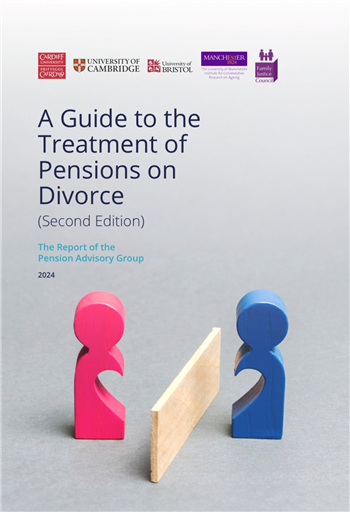
GA v EL [2023] EWFC 18731 October 2023
Published: 07/11/2023 11:29
https://www.bailii.org/ew/cases/EWFC/HCJ/2023/187.html
Peel J. Daniels v Walker application made by the Wife ('W') at a Pre-Trial Review in financial remedy proceedings.
Background
- The parties married in 2007 and separated in November 2019. They are in their early 50s and have two children.
- Modest non-business assets. In 2021 the parties took part in negotiations that led to an agreement to transfer the FMH to W. The parties did not reach an agreement about the business.
- The husband ('H') co-founded a software company ('the business') with his business partner in 2008. In 2014, H transferred 30% of the shareholding in the business to W. From April 2021, negotiations commenced for a potential sale of the business and in early 2022, the business was sold. H and W received c.£35m gross for their combined stakes with payment comprising i) cash ii) loan notes; and iii) shares in the purchasing company.
SJE Report & Daniels v Walker Application
Per H’s application, a direction was made in April 2023 for an SJE report regarding the value of the business upon separation (November 2019). The relevant issue was whether the business increased in value between separation and sale.
The SJE was to take a ‘present day approach’ whereby he would transport himself to November 2019 and reach a conclusion on the figures available without reference to subsequent figures. Cf. ‘hindsight approach’ whereby valuer would assess the value in November 2019, considering the relevant figures thereafter. The expert concluded the following:
- Per the ‘present day approach’, the parties’ combined interest in November 2019 was c.£14.1m gross;
- Per the ‘hindsight approach’, the parties’ combined interest in November 2019 was c.£18.9m.
W issued her Daniels v Walker application in October 2023, instructing her own expert. A report in support of this application concluded that per the ‘hindsight approach’, the parties’ combined interest in November 2019 was c. £20.5m.
The difference between the ‘hindsight approach’ taken by both experts is therefore £1.6m (£18.9m v £20.5m).
Issues
Peel J asserted that this was a single-issue case, centred upon the sale of the business, and framed the issue by reference to a three-stage inquiry:
- Did the value of the parties’ business interests increase after separation?
- If so, was that caused or contributed to by H’s asserted post-separation endeavour?
- If so, when undertaking the s 25 exercise, should the assets be split unequally in H’s favour (as he asserts) or equally (as W asserts)?
Law
- Robust reference (paras 16–24) is made by Peel J to E v L [2021] EWFC 60 in which Mostyn J concluded that a realistic valuation exercise must be based on actual figures (‘hindsight approach’) rather than adopting predicted figures and ignoring subsequent events.
- Peel J undertakes a helpful analysis of the relevant law on Daniels v Walker applications at paras 25–28. In particular, the definition of ‘necessary’ when approaching the relevant test (‘expert evidence is necessary to assist the court to resolve proceedings’ – FPR 2010 25.4). Peel J asserts that in this case he would draw particular attention to the ‘the overall justice to the parties in the context of the litigation’.
NB. Peel J cautions parties and the courts against commissioning reports in respect of historic values due to:
- The fragility of valuations; they are a product of art as much as science and must be approached with caution (Versteegh v Versteegh [2018] EWCA Civ 1050);
- The further into the past the valuer inquires, the less robust and more controversial the report;
- Ultimately, it is for the court to determine the extent of pre and post marital wealth (Hart v Hart [2017] EWCA Civ 1306);
- A historic, black letter accountancy valuation is not the only way to approach the issue (WM v HM [2017] EWFC 25 as approved by Martin v Martin [2018] EWCA Civ 2866); and
- Risk of satellite litigation due to potential Daniels v Walker applications.
Held
Daniels v Walker application fails. Peel J provides the following reasons for this decision:
- Application brought too late (under 3 weeks before final hearing); consequently, Peel J cannot accede to the application fairly without jeopardising justice to H and the case as a whole;
- Unclear as to whether experts would be able to answer questions, meet and prepare a schedule of agreed/disagreed areas before the trial;
- W can put issues raised by her expert (remaining as a shadow expert) to the SJE in cross-examination;
- Historic valuation is one factor amongst many for the court to consider. It is relevant to, but not determinative of, post separation accrual; and
- The difference in figures (£1.5m on the ‘hindsight approach’) is relatively small and unlikely to make a material impact.
Non-Compliance/Conduct
The non-compliance of both parties with the necessary case management requirements is raised by Peel J. Both parties lodged unduly long position statements in contravention of the 2016 High Court Efficiency Statement (W at 18 pages and H at 15 pages). The bundle consisted of 600 pages. Neither party sought permission to exceed the requirements. Peel J highlighted the following:
- Skeleton arguments must not exceed 10 pages (including any attached schedules) for first appointment or any other interim hearings (15 – Efficiency Statement).
- Bundles are limited to 350 pages (PD 27A 5.1)
- Matrimonial and Non-Matrimonial Property
- Post-Separation Accrual
- Daniels v Walker Application
- Experts
- Business Assets
- Efficient Conduct










